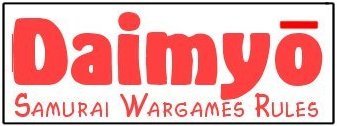

Daimyo - Samurai Wargames Rules
 |
 |
 |
 |
 |
 |
 |
 |
 |
 |
 |

Introduction
Daimyo is a set of wargames rules intended for use with
15mm scale wargames figures but can easily be used with other scales (although
I for one won't be painting any 6mm samurai!). The rules cover the period
known as The Age of the Country at War or Sengoku-Jidai.
This was a period when samurai armies became much more organised, the
importance of the ashigaru infantryman was recognised and the increasing
use of firearms altered samurai warfare forever. It was also an age that
produced some great commanders such as Oda Nobunaga, Toyotomo Hideyoshi,
Takeda Shingen, Uesugi Kenshin and Tokugawa Ieyasu to name but a few.
And, in a period of continual warfare, there were hundreds of battles,
some of them epic encounters like Nagashino, Sekigahara and Kawanakajima.
It is my hope that Daimyo will capture some of the excitement
of this colourful and unique period of history.
Why am I writing Daimyo?
There are already several sets of samurai wargames rules available. The
majority are skirmish rules where one figure represents one warrior. I
am aware of a few main battle sets, not counting generic rules such as
WRG's DBR. All of these rules have excellent features and show
a great love of the period by their authors. But like most wargamers,
I have my own ideas on what I like in a set of rules so I decided to try
writing my own set. Some of these other sets are reviewed here at the
Castle so gamers can decide if one or more sets suits them. I should point
out that Killer Katanas, in particular,
has excellent supplementary information on army lists, scenarios and tactical
deployment and is well worth buying for that alone.
The Rules
The rules are intended to be fast-playing with no order writing or other
paperwork necessary other than keeping note of leader ability ratings.
The main troop types include Samurai, Warrior Monks, Ronin, Ashigaru and
Peasants. Only samurai and warrior monks can be cavalry. Troops are also
rated for their morale, weapons and armour classes. Figures are mounted
on stands of fixed frontage and several stands (usually 4-6) make a unit.
Stand size and the number of figures on a stand is irrelevant so no re-basing
will be required. An army is organised into clans and a clan may consist
of one or more units.
During a game turn, each clan is activated sequentially, the order of which depends on a combination of leadership abilities of commanders and player choice. When active, the units of the clan may move and fight. Morale tests are taken when required. Mechanisms for movement, combat and morale are fairly conventional, with combat being evaluated on a per stand basis.
The game can optionally be driven by the use of a clan deck which is ideal for solo play but can be fun (and frustrating!) for more players. The deck consists of one card for each clan and each general. When a clan card is turned, the clan has the opportunity to become active and can move, fight and so on. Generals can join or leave units or lead their men on a glory charge! At the end of a turn when all clans have had the chance to activate, a few interesting events can occur before the deck is reshuffled for the beginning of a new turn.
What Next?
The rules are still being playtested at the moment, mainly solo but with
some two-player games. The current version is available from the link
below. This is far from the finished product but then is any set of rules
every really finished? Suggestions welcome. Just keep looking out for
updates and remember I can be contacted by email.

